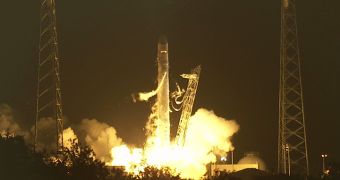Hawthorne, California-based Space Exploration Technologies Corporation (SpaceX) has made history earlier today, when it launched the first privately built spacecraft to the International Space Station.
The unmanned cargo ship lifted off from Space Launch Complex 40 (SLC-40) at the Cape Canaveral Air Force Station (CCAFS), aboard a Falcon 9 medium-lift delivery system. Blastoff occurred at 3:44 am EDT (0744 UTC) today, May 22.
This is the second demonstration mission that SpaceX is conducting under the $1.6 billion Commercial Orbital Transportation Services (COTS) contract it signed with NASA. The agreement calls for the company to conduct 12 resupply flights to the orbital lab over the next few years.
Falcon 9 had its maiden flight in June 2010, followed by its first mission carrying the Dragon space capsule, in December. During the first joint sortie to space, the capsule became the first private spacecraft to circle the globe, and then reenter Earth's atmosphere successfully.
Subsequently, SpaceX requested and was granted permission to combine two test missions into a single flight. This is how the company was allowed to attempt an orbital docking maneuver with the ISS.
The Dragon will not head for the station directly. It will first carry out a flyby of the orbital outpost on Thursday, May 24, during which SpaceX will assess its sensors and flight systems. The capsule will pass within 1.5 miles (2.4 kilometres) of the outpost.
If everything checks out, NASA will allow the vehicle to attempt a dock on Friday, May 25. Since Dragon has no automated docking mechanism, it will pass very close to the space lab, while astronauts aboard the ISS will use the Canadarm-2 robotic arm to capture it.
Once this maneuver is complete, the arm will guide the spacecraft to the American docking port. This is the same approach used by the Japanese Aerospace Exploration Agency on its HTV spacecraft.
“I want to congratulate SpaceX for its successful launch and salute the NASA team that worked alongside them to make it happen,” NASA Administrator Charles Bolden commented after the launch.
“Today marks the beginning of a new era in exploration; a private company has launched a spacecraft to the International Space Station that will attempt to dock there for the first time,” the official added.
“And while there is a lot of work ahead to successfully complete this mission, we are certainly off to good start. Under President Obama’s leadership, the nation is embarking upon an ambitious exploration program that will take us farther into space than we have ever traveled before, while helping create good-paying jobs right here in the United States of America,” he concluded.

 14 DAY TRIAL //
14 DAY TRIAL //